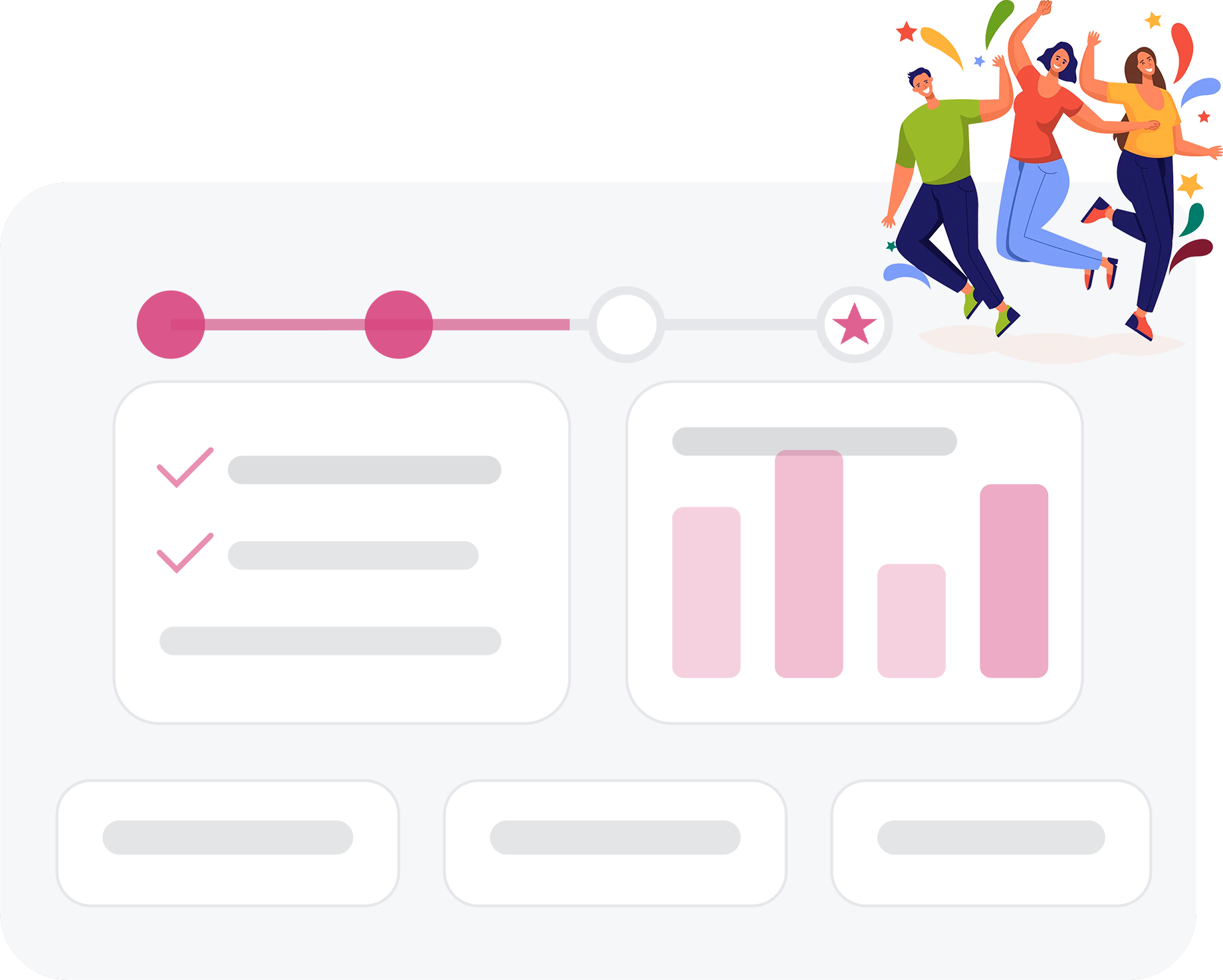 What is Organizational Resilience?
What is Organizational Resilience?
Organizational resilience is how well a company can handle change and sudden problems, keeping it going and helping it grow.
It shows how good a company is at dealing with hard times, like money troubles, big storms, market changes, online dangers, or big health issues like the COVID-19 virus.
How to build Organizational Resilience?
To build organizational resilience, focus on fostering adaptability, agile decision-making, Culture and Leadership, Networks and Partnerships, Resources and Assets and robust risk management strategies.
According to a McKinsey & Company research, organizations are confronted with a new normal of frequent business shocks, demanding swift responses for success and survival. However, many lack a holistic approach to transform structures, processes, and people to bounce forward after crises. Research emphasizes the importance of organizational resilience, but few feel adequately prepared for future disruptions, with only a small percentage adopting fully agile operating models.
Companies that prioritize adaptability and resilience can turn shocks into opportunities for sustainable growth, outperforming peers during crises and generating higher shareholder returns. The advantages of getting resilience right are evident in both downturns and recovery periods, making it crucial to embrace a comprehensive approach to organizational preparedness in today’s dynamic and interconnected business landscape.
To address these challenges and enhance organizational resilience, the GFoundry platform can play a crucial role. This platform offers tools and resources that enable companies to prioritize adaptability and resilience. By using GFoundry, organizations can create a more agile operating model, allowing them to respond swiftly to changing circumstances and capitalize on opportunities for sustainable growth.
How do you build a resilient workforce?
Building a resilient workforce is crucial for organizations, especially in an era of rapid change, uncertainty, and unexpected challenges. Resilience means that employees can bounce back from setbacks, adapt to change, and keep going in the face of adversity. Here are some steps and strategies to cultivate resilience in your workforce:
- Leadership and Culture:
- Role Modeling: Leaders should lead by example, demonstrating resilience in their own actions and decisions.
- Open Communication: Promote an environment where employees can express concerns, seek feedback, and share challenges.
- Training and Development:
- Resilience Workshops: These can teach employees coping mechanisms, stress management techniques, and problem-solving skills.
- Continuous Learning: Offer opportunities for employees to upskill, which can build their confidence and adaptability.
- Support Systems:
- Mentorship Programs: These allow experienced staff to guide and support less experienced members.
- Peer Support Groups: These can help employees share challenges and solutions.
- Work-Life Balance:
- Flexible Working Hours: This can help employees balance personal and professional obligations.
- Remote Work Options: Can reduce the stress of commuting and offer a more comfortable work environment for some.
- Mental Health Days: Recognize the importance of mental health and provide days off specifically for mental rejuvenation.
- Health and Wellbeing Programs:
- Physical Health: Offer programs or incentives for physical exercise, as physical health often correlates with mental resilience.
- Mental Health Resources: Provide access to counseling or resources that support mental well-being.
- Feedback and Recognition:
- Regular Feedback: Constructive feedback helps employees understand where they need to improve and where they excel.
- Recognition: Celebrate successes, big or small, and acknowledge hard work.
- Clear Expectations:
- Job Clarity: Ensure that employees know what’s expected of them.
- Provide Resources: Make sure employees have the necessary tools, training, and resources to fulfill their roles.
- Encourage Innovation and Creativity:
- Promoting a growth mindset helps employees see challenges as opportunities to learn and grow, rather than threats.
- Diversity and Inclusion:
- A diverse and inclusive workforce can offer a wider range of perspectives and solutions, making it more adaptable to challenges.
- Emergency Preparedness:
- Conduct regular drills or training sessions for different kinds of crises, so employees are prepared and know how to respond.
- Encourage Taking Breaks:
- Regular breaks can prevent burnout and allow employees to recharge.
- Safe Environment:
- Ensure that the workplace is free from bullying, harassment, and other negative behaviors. Employees should feel safe to speak up without fear of retaliation.
- Provide Opportunities for Growth:
- Career advancement opportunities, cross-training, or lateral job moves can keep employees engaged and motivated.
Increase speed, strengthen resilience
Companies should always be ready and fast in action. In today’s uncertain world, being resilient and quick can make or break success. But, our studies show that not all companies prepare well. Some focus on only one aspect of readiness, like dealing with a specific problem. They don’t consider the whole picture: regularly updating their structures, processes, and people. This way, they not only recover from crises, but also advance – landing safely and moving forward with fresh energy.
Crises are bound to happen. Today’s global business world is fast-paced, interconnected, and complex.
People know how crucial it is for organizations to be resilient. Over 60% of people surveyed believe it will become even more vital in the future. However, many feel that their organizations aren’t prepared enough for the potential shocks in the next few years.
1. Many business leaders say they feel that their organizations are unprepared to react to future shocks and disruptions.

2. Organizations with healthy, resilient behaviors were better able than those with poor organizational health to withstand major disruptions in 2020-21.
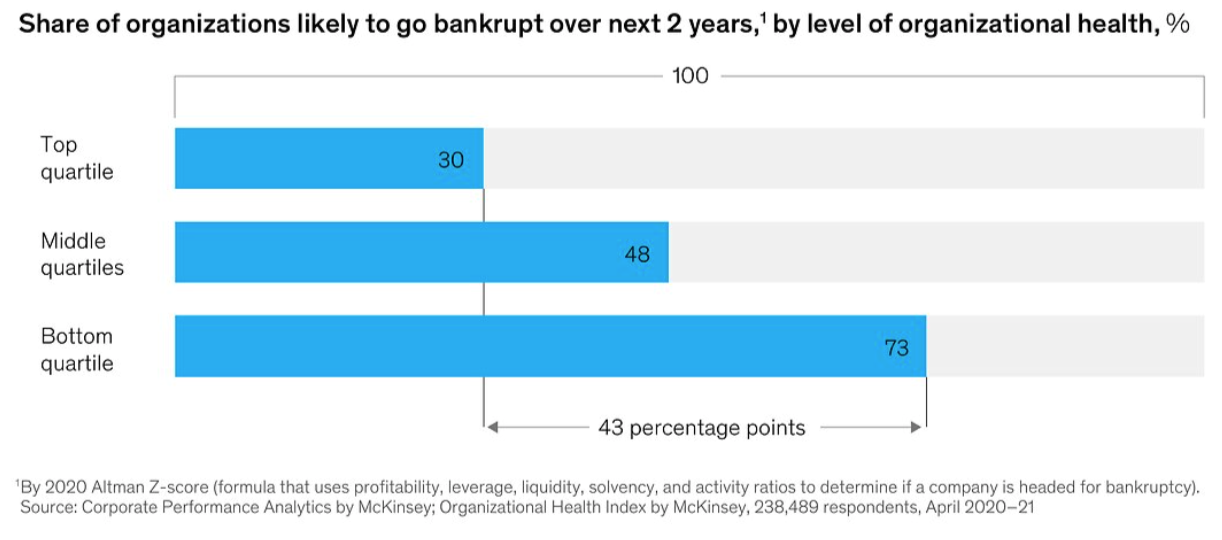
3. Obstacles to strengthening resilience range from a lack of resources to dramatic differences between hierarchy levels and functions.
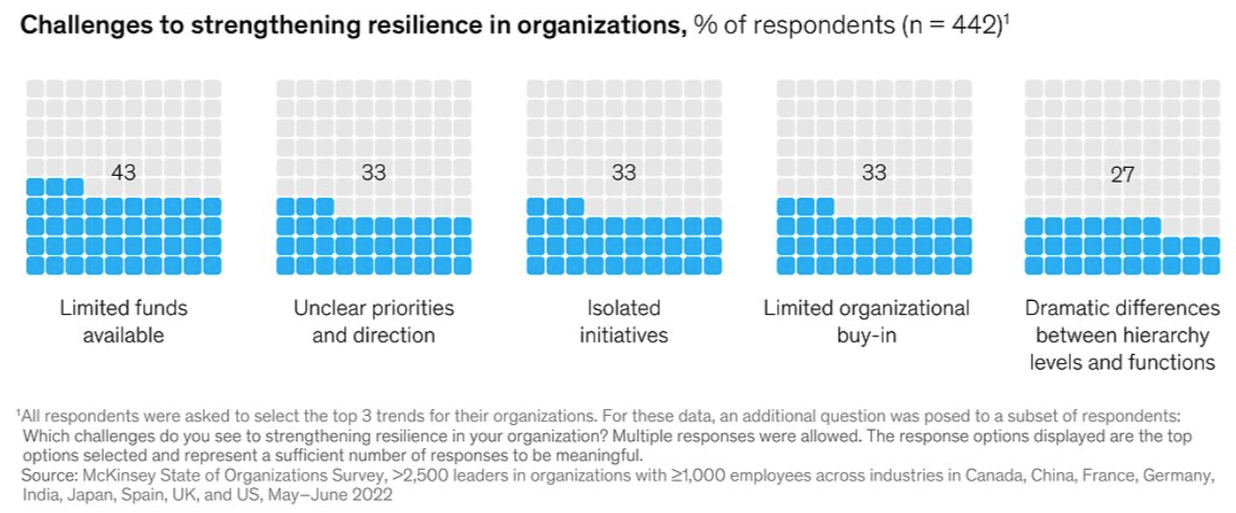
How can organizations unlock the power of true hybrid work and adapt to dynamic work dynamics for success?
According to McKinsey, in recent times, organizations have experienced a significant shift in work dynamics. Formerly expecting employees to spend the majority of their time in the office, now only around 10 percent do, while 90 percent have embraced hybrid work models. Employees value this flexibility and balance, with over four out of five preferring to retain the hybrid model.
To succeed in this evolving landscape, organizations must determine the best combination of remote and in-person work that suits their workforce’s specific needs. Embracing the “true hybrid” approach, where policies and workflows guide employees on the optimal format for activities, allows organizations to attract and retain top talent and enhance overall productivity. This dynamic journey towards flexible work models continues to shape the future of work, offering boundless opportunities for those willing to adapt.
Keep on reading: The Ultimate Guide to Remote Talent Management
4. Survey respondents expect to see more, not less, remote work.
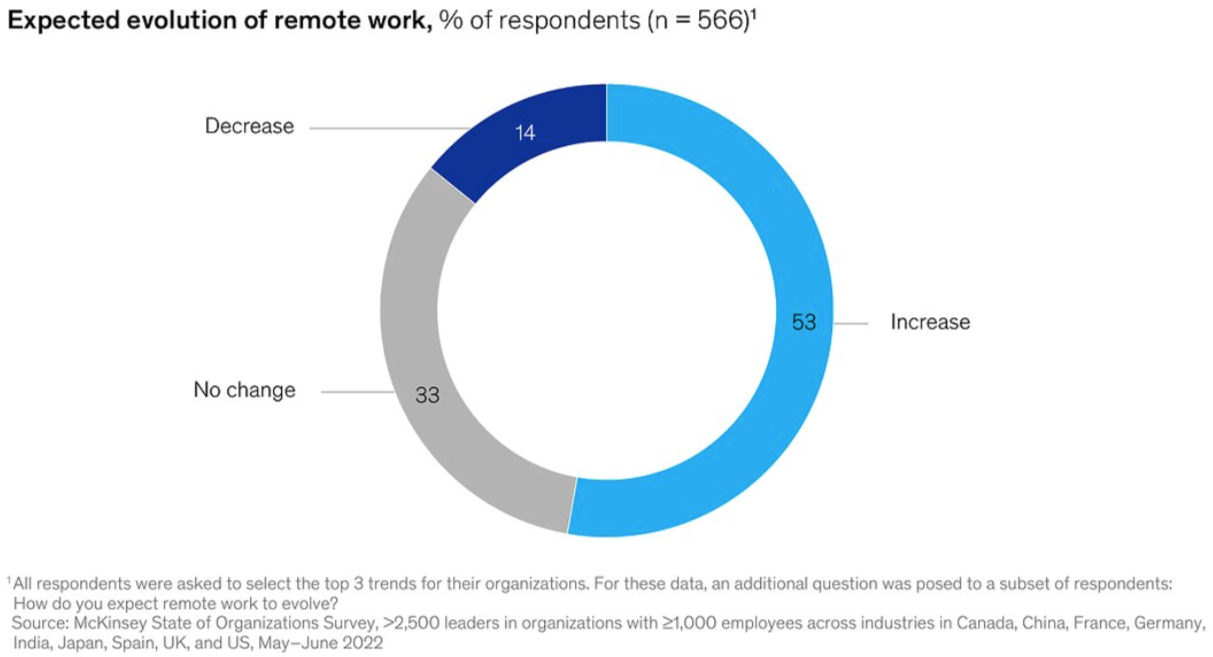
5. Survey respondents report that team leaders are uncomfortable leading remote teams.

AI-Driven Transformation. How can AI help organizations?
AI can help organizations by driving transformation through automation, data analysis, predictive insights, enhanced decision-making, and improved customer experiences.
6. Survey respondents report existing or impending capability gaps in technology-oriented roles.
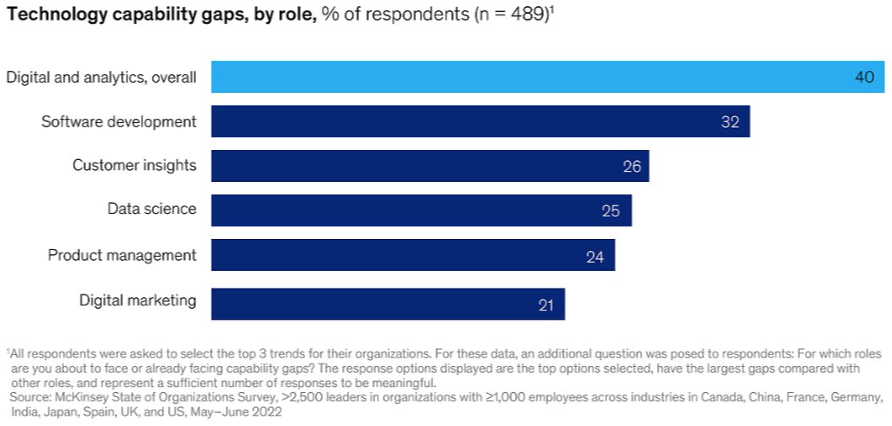
The adoption of AI is on the rise, with over half of respondents in a McKinsey Global Survey already using AI in their business units, and even more expecting increased investments in AI in the coming years. AI-driven organizations are revolutionizing talent management, processes, and structures.
AI has transformed talent management, facilitating skill-based hiring by matching candidates’ attributes to open positions and reducing human biases in the screening process. AI-based learning management systems and employee experience platforms enhance employee development and engagement. Companies also leverage AI to improve collaboration, communication, and team dynamics.
How to attract and Retain Top Talent in a Transformed Work Landscape?
To attract and retain top talent in a transformed work landscape, focus on offering flexible work options, nurturing a positive company culture, create initiatives to help meet individualized needs, providing opportunities for career growth, and ensuring competitive compensation and benefits.
In the wake of the COVID-19 pandemic and the subsequent “Great Attrition,” senior leaders worldwide are facing a scarcity of human capital. Job openings are difficult to fill, and employee retention and engagement have become pressing concerns. Despite the high attrition rates, many employers underestimate the number of employees planning to leave, including the “quiet quitters” who are disengaging in various ways.
Employees are reshaping their work-life boundaries, with some transitioning to new roles and others leaving the workforce entirely. Different age groups, life stages, and work experiences influence what employees seek from their jobs, such as flexible hours, remote work, meaningful tasks, and fair compensation.
Keep on reading: How to Attract, Retain, and Develop Top Talent with GFoundry Platform.
7. Companies can gain a competitive edge with a dual focus on people and performance.
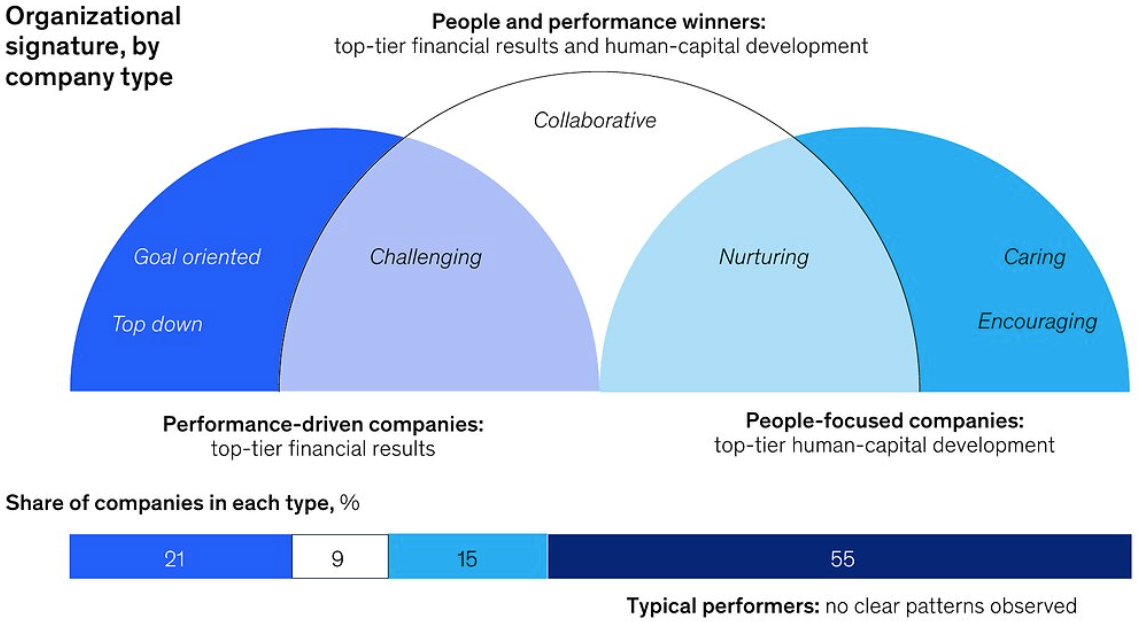
8. Survey respondents say their organizations expect continued workforce turnover in the first half of 2023.

9. To attract and retain employees, companies can consider individualized needs.
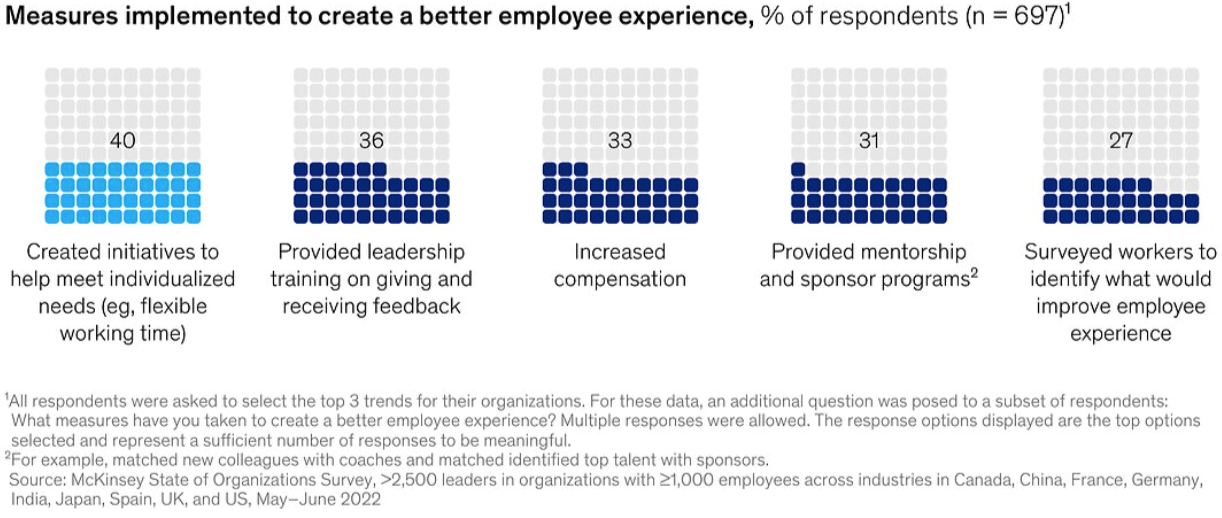
Can Building Institutional Capabilities Lead to Sustained Growth and a Competitive Advantage?
Yes, building institutional capabilities can lead to sustained growth and a competitive advantage.
The workplace is experiencing a shift due to the increasing deployment of new technologies like automation and AI. As the skills needed for growth and value change, companies face capability gaps and seek to build institutional capabilities to stay competitive. These institutional capabilities encompass an integrated set of people, processes, and technology that enable consistent superiority over competitors.
However, many organizations lag in core activities due to insufficient resources or commitment to capability building. In a survey, 90 percent of respondents recognized the urgency to act on capability building, but only 5 percent felt their organizations’ capabilities were already established. Getting capability building right is crucial, as it leads to long-term growth and skill gap closure, benefiting both companies and employees.
Keep on reading: Creating an innovative learning and development ecosystem with GFoundry
10. Survey respondents believe that their organizations should make capability building a priority.

11. Organizations lack the time, leadership support, and resources to build new capabilities internally.
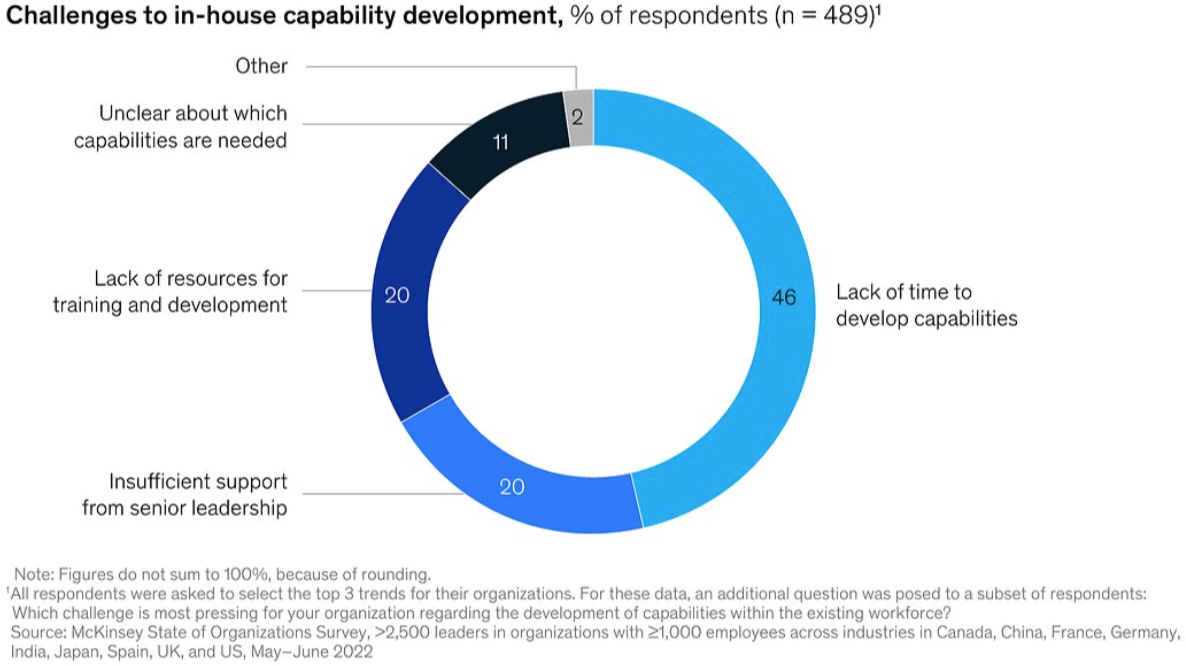
12. Organizations are having a hard time acquiring employees to build new capabilities.

Optimizing Talent Allocation: How Can Organizations Strategically Align Talent with High-Value Roles within Budget Constraints?
Organizations can manage talent within budget constraints by identifying the most critical roles and their high performers, and prioritizing talent allocation based on strategic needs and budget constraints.
Business leaders face the complex task of balancing budgets while retaining key talent. As organizations strive to protect their businesses in the short term and set them up for long-term success, a critical focus is on matching top talent to high-value roles. This becomes increasingly vital as the importance of tech specialists and digital capabilities grows, with many companies citing a lack of key skills in areas such as digital analytics and software development.
McKinsey research highlights the significant impact of high performers, with only 5 percent of employees delivering 95 percent of an organization’s value. Companies that reallocate top performers to critical roles regularly outperform competitors. However, many organizations struggle with identifying the most critical roles and their high performers, with 46 percent of respondents lacking clarity on this matter. This lack of transparency poses challenges in understanding which skills drive organizational value and hinders effective talent development efforts.
Keep on reading: Performance and potential assessment: identify your top performers
13. Survey respondents are unclear about which roles are the most critical in value creation.

14. Survey respondents cite several challenges to identifying the most critical talent and roles in their organizations.
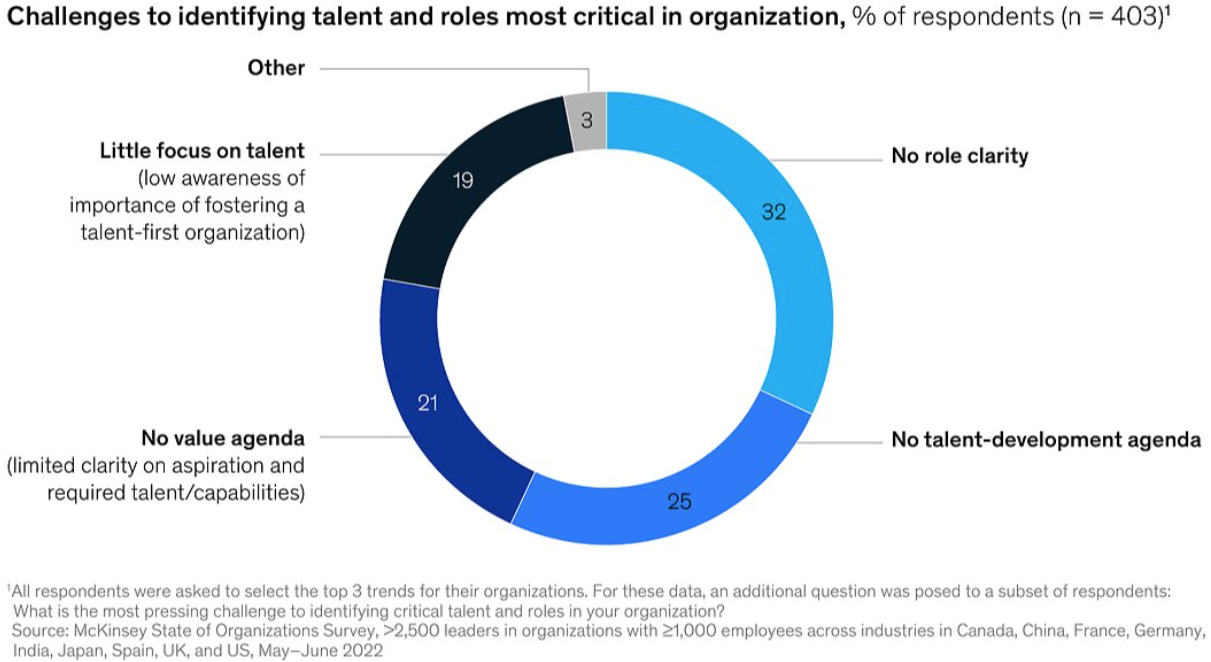
Is Your Leadership Fit for Today’s Turbulent Environment?
In today’s turbulent environment, leaders face a crucial choice: stick with familiar approaches that may no longer be effective, or embrace change and rethink their leadership strategies. Remaining in the comfort zone could lead to alienating stakeholders, including employees who may feel demotivated and overwhelmed. A mere 25 percent of respondents in the State of Organizations Survey believe their leadership culture inspires employees to their fullest potential.
Successful leadership in the present landscape requires three layers of capability: leading oneself, leading a C-suite team, and exhibiting the skills and mindset to lead at scale, coordinating and inspiring networks of teams. This task demands a keen awareness of oneself and the operating environment. The benefits of effective leadership are substantial, with inspiring leadership driving stakeholder and employee satisfaction. High-performing CEOs have the potential to generate $5 trillion in excess value, significantly impacting a company’s performance and employee experience. Scaling leadership throughout the organization is a critical facilitator for success.
15. Only one-quarter of survey respondents see their leaders as inspirational and fit for purpose.
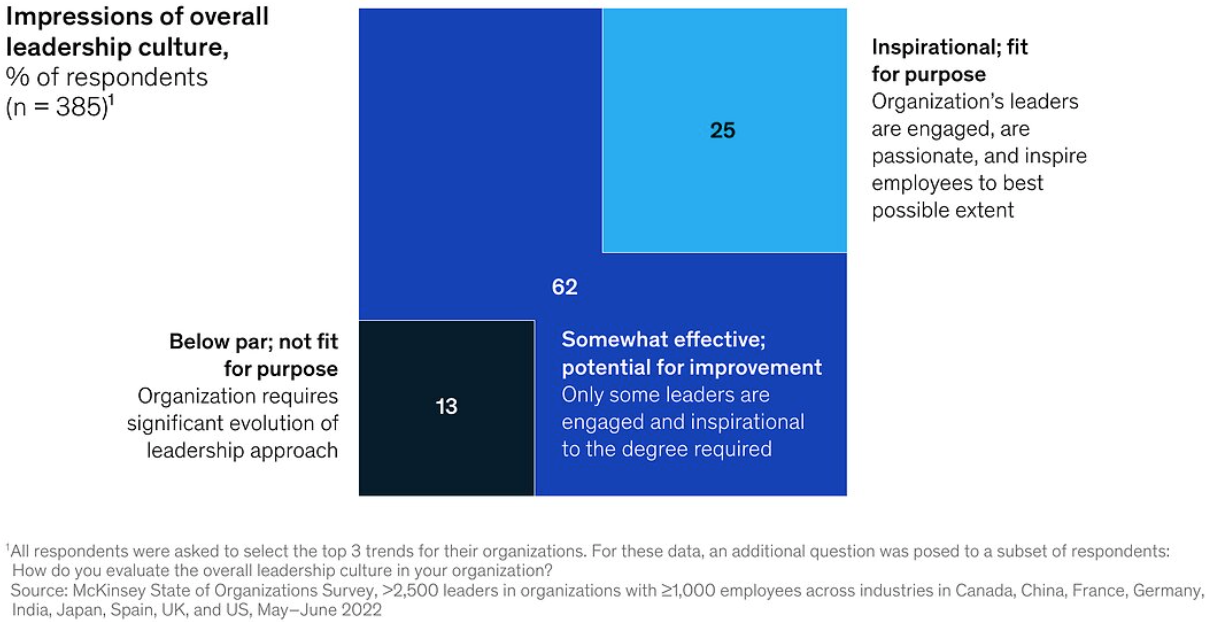
16. Respondents value human-centered aspects of leadership.

17. Respondents say a range of challenges can prevent a change in leadership styles in organizations.

18. Respondents say their organizations are taking steps to improve their leadership cultures.
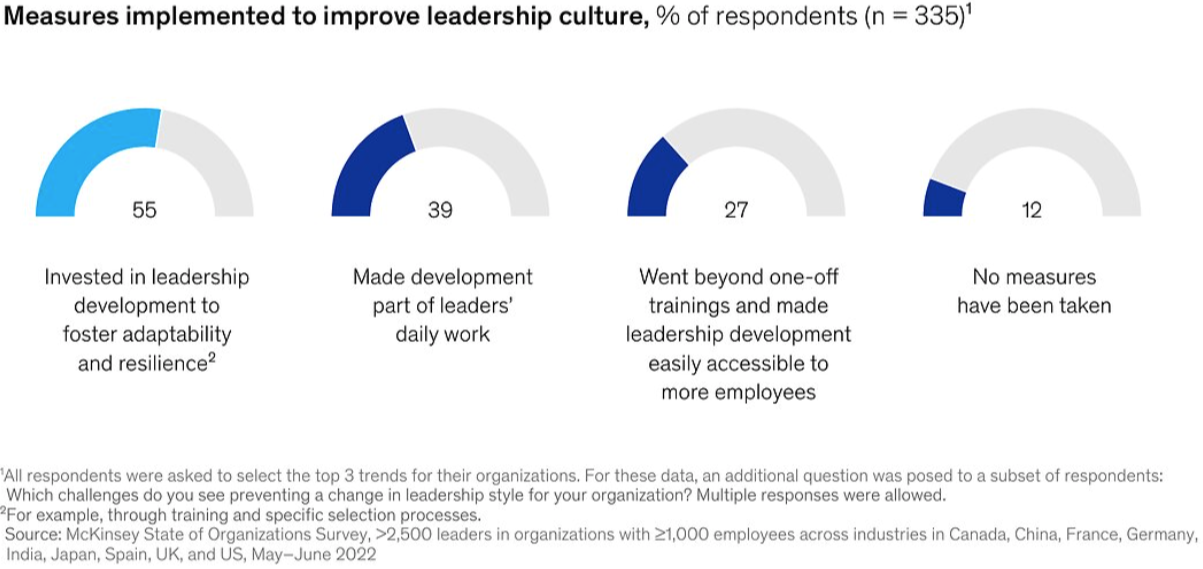
 Is Diversity, Equity, and Inclusion (DEI) Driving Organizational Progress?
Is Diversity, Equity, and Inclusion (DEI) Driving Organizational Progress?
Yes, Diversity, Equity, and Inclusion (DEI) can significantly drive organizational progress.
In recent years, organizations have increasingly prioritized Diversity, Equity, and Inclusion (DEI) initiatives across their product development, hiring, and talent management processes. Despite economic challenges, many organizations remain committed to these efforts. However, there is a disconnect between their intentions and actual progress. While diversity initiatives have shown some advancement, equity and inclusion efforts still lag behind.
McKinsey research reveals that over 70 percent of companies aspire to transformative DEI goals, but only 47 percent have the necessary infrastructure to achieve them. Additionally, more than 20 percent of respondents in the State of Organizations Survey cannot confirm a sense of community and inclusion within their organizations. This lack of community is often experienced by employees in underrepresented groups, who may be less likely to respond to surveys.
When implemented comprehensively, robust DEI practices become a competitive advantage. Companies with diverse executive teams outperform their peers in profitability, with ethnic diversity contributing to a 36 percent increase and gender diversity contributing to a 25 percent increase. Moreover, organizational DEI can attract top talent and unlock the full potential of a diverse workforce, fostering a more inclusive and successful environment.
Keep on reading: Promote and manage diversity and inclusion in your company
19. Respondents say their organizations are taking steps to boost diversity, equity, and inclusion.
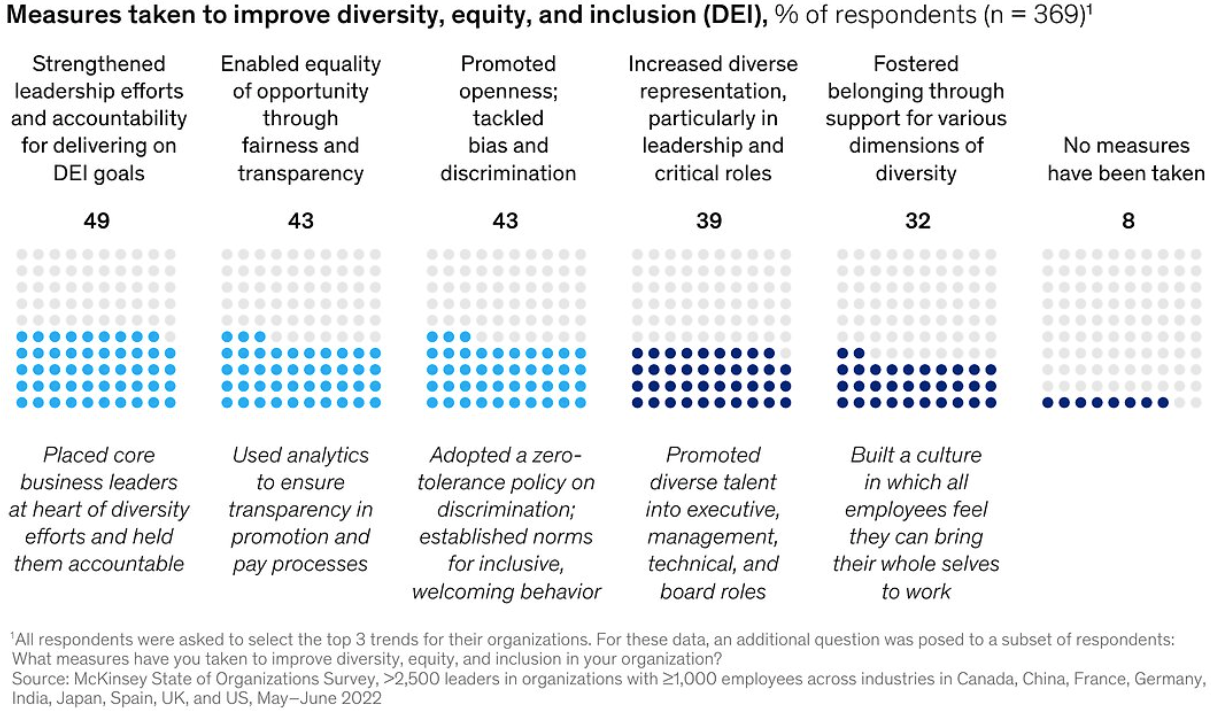
20. Whether internally or externally focused, diversity, equity, and inclusion initiatives can be placed on a spectrum of impact.
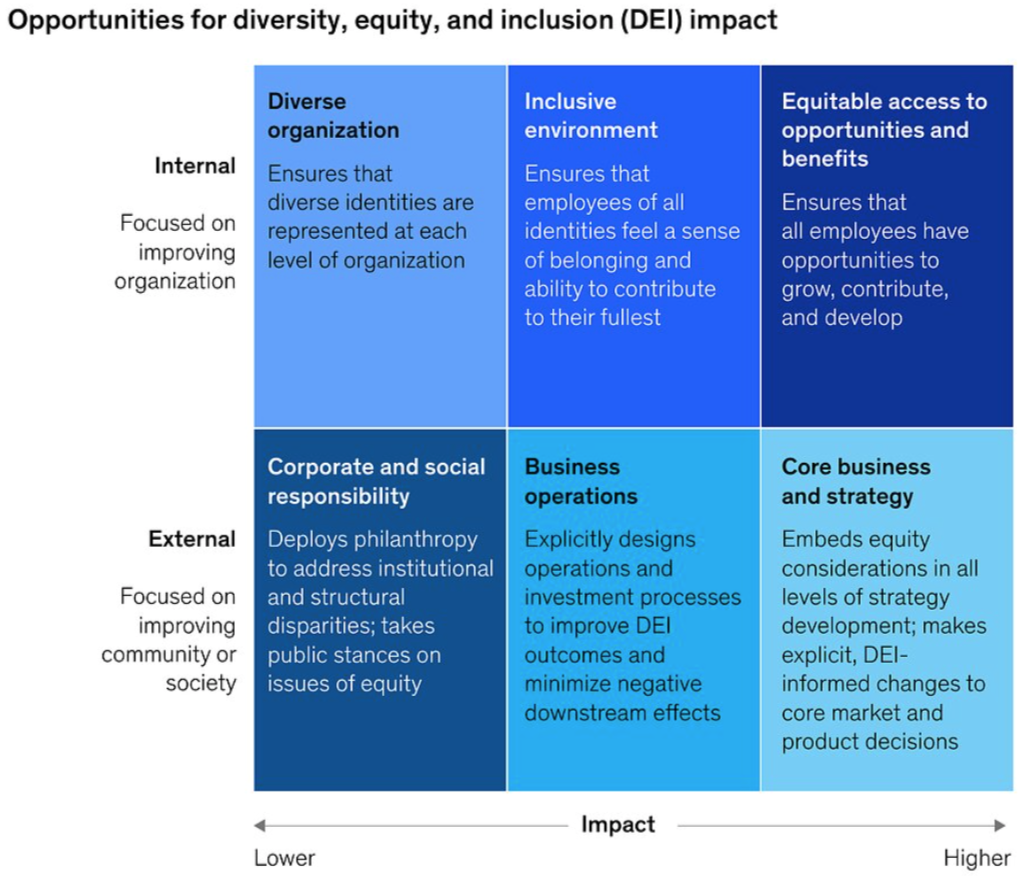
Is Prioritizing Mental Health and Well-Being the Key to Sustainable Business Success?
Yes, prioritizing mental health and well-being is crucial for sustainable business success. By acknowledging the prevalence of mental health challenges among employees and offering structured wellness programs, organizations can create a supportive and thriving workplace culture.
Keep on reading: Employee well-being – the complete guide
21. The state of employees’ mental health and well-being exists along a continuum, from languishing to flourishing.
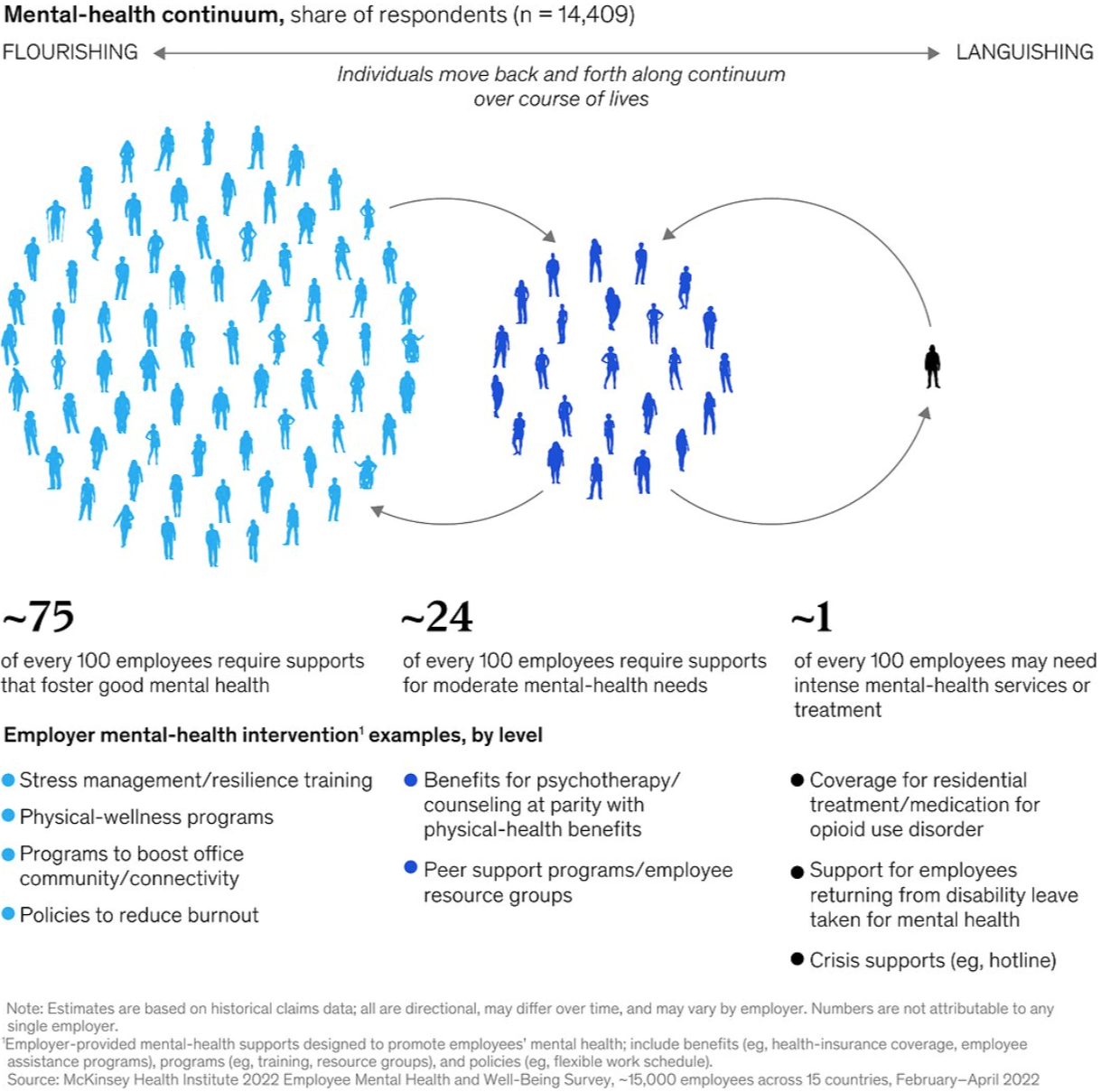
Research indicates that nearly 60 percent of individuals have experienced mental health challenges at some point in their lives, regardless of country, industry, age, role, or gender. As a result, mental health and well-being have become top priorities for HR leaders worldwide, with nine out of ten organizations offering structured wellness programs to employees. However, many employees still feel overwhelmed, prompting a call for systemic interventions to address the root causes of poor mental health.
The benefits of investing in mental health and well-being extend beyond moral responsibility. Addressing these issues can lead to a sustainable competitive advantage, with potential improvements in retention, attraction, and productivity. Currently, billions of working days are lost annually worldwide due to depression and anxiety, costing around $1 trillion in lost productivity. Additionally, employees facing mental health challenges may have worse experiences at work and higher turnover intentions compared to their peers without such challenges.
Are Organizations Ready to Embrace Efficiency in a Shifting Business Landscape?
While some organizations have already taken steps to embrace efficiency, many are still in the process of adapting to the changing business landscape.
Organizations are facing a growing mismatch between existing operating models and market realities, leading to increased focus on efficiency measures. More than one-third of leaders in the State of Organizations Survey consider efficiency a top priority for the coming years. Many organizations have SG&A expenses exceeding 20 percent, and hierarchies with multiple layers separating the CEO from the front line, causing inefficiencies and unnecessary interactions.
Fixing the foundations of how work gets done and empowering employees with decision rights are vital for improving organizational health and accountability. Improving role clarity and simplifying structural complexities can significantly enhance an organization’s efficiency. Additionally, companies that actively reallocate resources to more strategic areas, both financially and in terms of talent, deliver higher total shareholder returns (TSR).
Keep on reading: Unlocking Efficiency with OKRs: Maximizing Organizational Performance
22. Survey respondents point to seven root causes of organizational inefficiency.
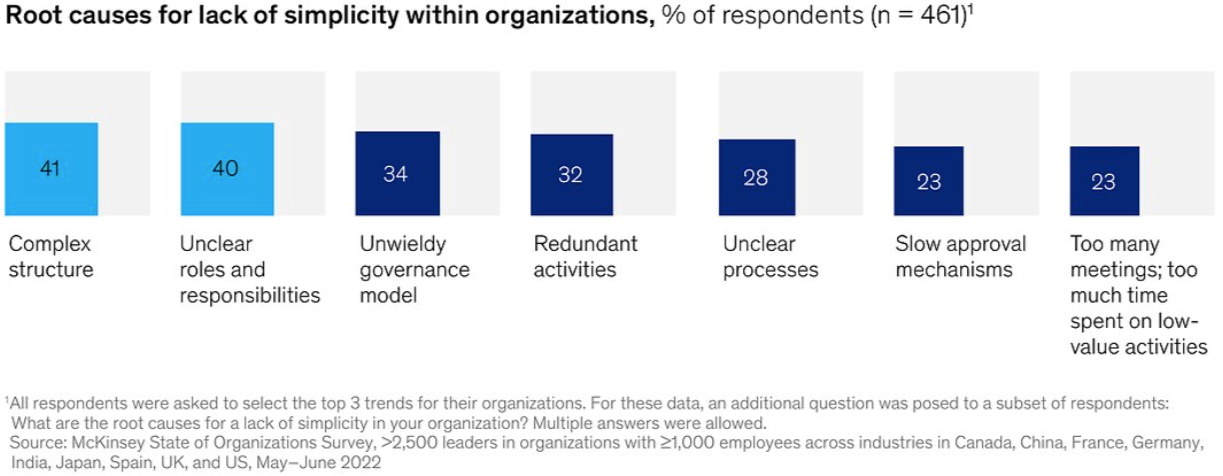
23. Survey respondents say they don’t have enough resources to increase organizational efficiency.
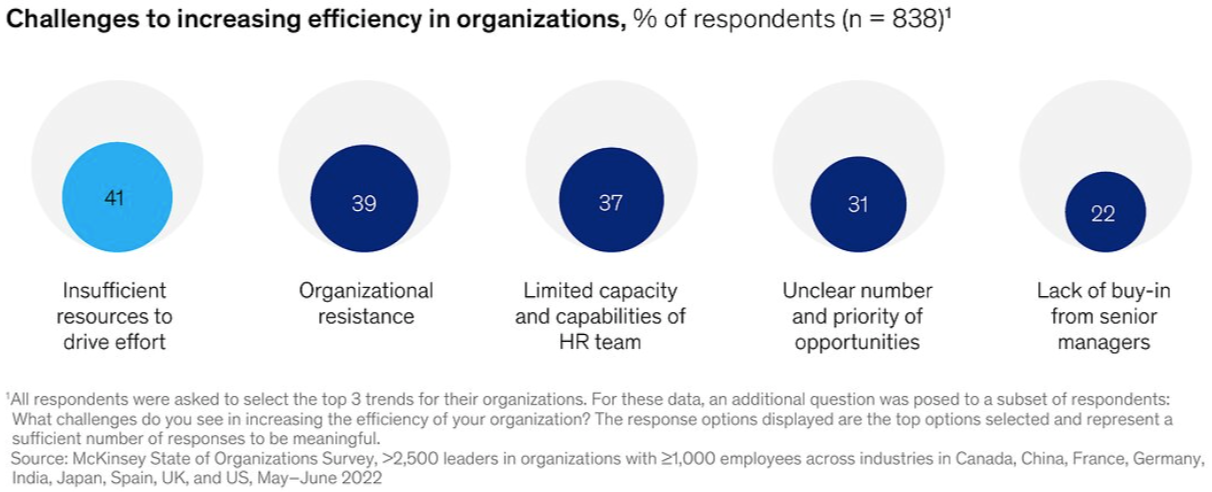
Subscribe to GFoundry Newsletter: Weekly Insights on HR’s Most Pressing Topics
Ready to get started?
Take the next step and learn more about how GFoundry can help you.
